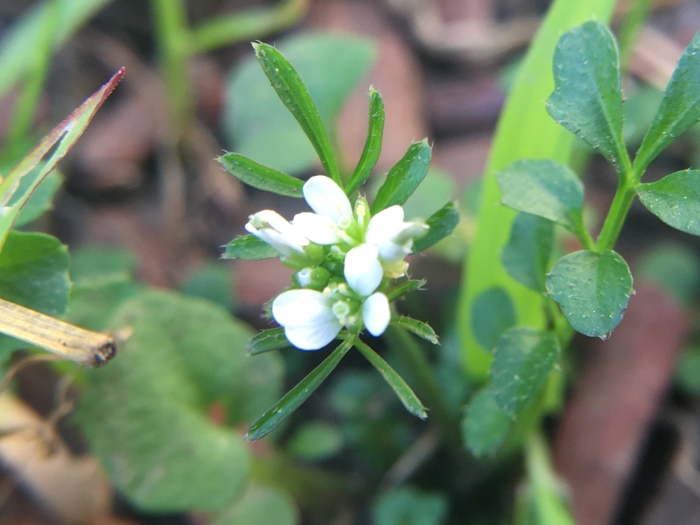Hairy Bittercress
(Cardamine hirsuta)
Hairy Bittercress (Cardamine hirsuta)
/
/

© Zinogre
CC BY-SA 4.0
Image By:
© Zinogre
Recorded By:
Copyright:
CC BY-SA 4.0
Copyright Notice:
Photo by: © Zinogre | License Type: CC BY-SA 4.0 | License URL: http://creativecommons.org/licenses/by-sa/4.0/ | Uploader: zinogre | Publisher: iNaturalist |
























Estimated Native Range
Summary
Cardamine hirsuta, commonly known as hairy bittercress, is an annual or biennial herb native to Europe and Asia but has naturalized in many parts of the world, including North America. It typically inhabits moist, disturbed sites such as fields, gardens, and greenhouse environments. The plant reaches a modest height of 3-12 inches (7.5-30 cm) and forms a basal rosette of leaves. The leaves are compound with several small leaflets and covered with fine hairs, giving the plant its common name. Hairy bittercress blooms early in the spring, displaying small, white, four-petaled flowers that are quite showy given the plant’s overall size. After flowering, it produces slender seed pods (siliquae) that explosively dehisce, effectively dispersing seeds over a considerable distance.
Hairy bittercress is valued for its early spring flowers and its edibility, with young leaves often used in salads for a peppery flavor. It is easy to grow and maintain, thriving in cool, moist conditions, and can be found in urban gardens, containers, and as a ground cover in shaded areas. It prefers moist, well-drained soils and can tolerate a range of light conditions from full sun to partial shade. While it is not typically cultivated for ornamental purposes, it can be an attractive addition to early spring gardens. However, gardeners should be aware of its invasive potential and manage its spread by removing plants before seed set.CC BY-SA 4.0
Hairy bittercress is valued for its early spring flowers and its edibility, with young leaves often used in salads for a peppery flavor. It is easy to grow and maintain, thriving in cool, moist conditions, and can be found in urban gardens, containers, and as a ground cover in shaded areas. It prefers moist, well-drained soils and can tolerate a range of light conditions from full sun to partial shade. While it is not typically cultivated for ornamental purposes, it can be an attractive addition to early spring gardens. However, gardeners should be aware of its invasive potential and manage its spread by removing plants before seed set.CC BY-SA 4.0
Plant Description
- Plant Type: Herb
- Height: 0.25-0.75 feet
- Width: 0.25-0.5 feet
- Growth Rate: Rapid
- Flower Color: White
- Flowering Season: Spring
- Leaf Retention: Deciduous
Growth Requirements
- Sun: Full Sun
- Water: Medium
- Drainage: Medium
Common Uses
Edible*Disclaimer: Easyscape's listed plant edibility is for informational use. Always verify the safety and proper identification of any plant before consumption., Groundcover, Low Maintenance
Natural Habitat
Native to Europe and Asia, naturalized globally in moist, disturbed sites
Other Names
Common Names: Hairy Bittercress, Lamb’s Cress, Common Bittercress, Hoary Bittercress, Land Cress, Spring Cress
Scientific Names: , Cardamine hirsuta, Arabis heterophylla, Arabis heterophylla, Cardamine angulata, Cardamine angulata var. alba, Cardamine borbonica, Cardamine fagetina, Cardamine hirsuta f. apetala, Cardamine hirsuta f. coerulescens
GBIF Accepted Name: